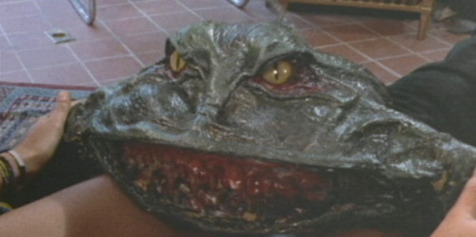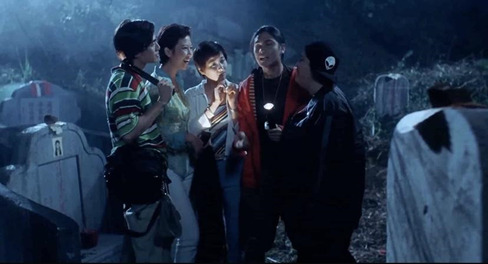SIGN UP TO OUR NEWSLETTER FOR DISCOUNTS, PROMOTIONS and PRIZES!
Ten underrated 1990s horror movies
1. Strangeland (John Pieplow, 1998)

This highly influential film barely receives any credit for being a significant instigator within the world of technology based horror. The film centres upon a deluded internet creep nicknamed ‘Captain Howdy who lures his victims in via an online chat forum. But what makes Strangeland sinisterly standout is Howdy’s malicious methods he exacts upon his prey, including ritualistic pain and body modification.
The abject reaction of the body being modified in nonconforming ways grips the audience and unfortunately makes us unable to turn away from such gruesome sights. Of course, these aspects of modern primitive culture are seen as a rite of passage in many environments, however Howdy graphically enforces his ethos amongst innocent victims. Yet, Strangeland does not overtly fall into the trap of ‘torture-horror’ as the story primarily focuses upon the judicial process of a detective attempting to save society from these savage antics.
2. Idle Hands (Rodman Flender, 1999)

Idle Hands has all the elements of a 1990s teen horror, however instead of being discernibly formulaic, Flender leads the film with a dark slice of humorous energy. The film follows Anton (Devon Sawa), whose possessed hand takes him on a murderous rampage.
At the time of release Idle Hands received mixed reviews, with many of the feedback falling towards the negative side. Critics labelled the film as nonsensical and absent minded, but from a retrospective point of view it is these attributes that make Idle Hands an entertaining ride into the obscure and absurd. The frenzied plot elements allow for audiences to get lost within the hilariously yet disturbed story.
3. Cure (Kiyoshi Kurosawa, 1997)

Cure is possibly one of the most undeservedly underrated horrors ever, with such elaborate craftsmanship and highly engrossing plot lines going under so many viewers’ radars. Cure follows a detective as he attempts to uncover the identity of a gruesome serial killer whose signature is carving an ‘X’ into his victim’s necks. The film was one of the original authors in forming the new wave of Japanese horror, thus establishing the archetype for hits such as Ringu and Ju-on.
Throughout the film we experience a lack of horror tropes and ghouls, instead we are gifted with the bare minimum. Horror does not have to be gratuitous and grand within its execution, instead empty space and strong horrific emotions such as grief and threat is enough to achieve great levels of horror. Cure is a highly acclaimed film, with audiences and critics adoring Kurosawa’s lingering visuals. However, the primary reason for its entry on this list is due to the sheer lack of acknowledgement that Cure has been subjected to since its release. Cure should rightfully shine in every ‘top 10 list’.
4.Cronos (Guillermo del Toro, 1993)

Although del Toro is now a beloved auteur, his early work is where his horror roots truly beamed. Cronos’ plot is best left to the surprise, but the basic premise follows the discovery of a small golden device that unleashes its addictive force amongst its possessor. The film spiritually embodies the role of a mythological tale, whilst exploring the potent power of immortality alongside grotesque imagery.
Such aspects are gradually uncovered in a particular way that tiptoes towards a metaphorical framework, surrounding itself with the temptation of prolonged existence. Cronos entices the viewer in with an intriguing storyline, but before audiences can get too comfortable del Toro exerts harsh moments of horror and desperation to create a memorable film that has a long reputation of being misunderstood and underappreciated.
5. Thesis (Alejandro Amenábar, 1996)

Thesis follows a young student who investigates the relationship between audiovisual media and violence, however events take a turn for the worst when she uncovers an unsettling snuff film. Thesis disavows the audience from cementing any expectations as Amenabar continuously mystifies the identity of who created this snuff film.
What makes Thesis work so well is the constant development of characters, not once can we reach a solid conclusion on whether to trust a particular character, even the lead protagonist. It’s this dimensionality that makes the film gripping throughout. Thesis runs with the detective-thriller craze that majorly bombarded the 1990s, with Seven being the lead example.
6. Nadja (Michael Almereyda, 1994)

Nadja transforms the classic vampire tale through reconstructing vampiric tropes within horror. We follow the story of contemporary vampires from New York as they set aside their dysfunctionalities to come together after their fathers death, all the whilst Van Heilsing threatens to interrupt their debilitated harmony.
The most notable reason as to why Nadja is a must-see is the film’s overt presence of a semi-arthouse style combined with a unique drawl that showcases a distance between the characters and the audience. There is no need to emotionally connect with the leads, we are instead here to witness a witty story that sophistically alludes to a purposeful deadpan humour.
7. Cube (Vincenzo Natali, 1997)

Cube is a uniquely crafted film that follows a motley crew of individuals who are trapped in a complex and dangerous trap to see how far one will go to survive these vicious traps. Cube only gained a small fraction of attention upon its release, and although it now has taken over a niche corner in the genre through its cult status, it is still a relatively unknown gem.
There are an array of visceral scenes that illustrate just how damaging these traps are, but the most enchanting aspect of Cube surrounds its concept. The box-like setting has been referred to as Kafkaesque due to the disorientating and helpless nature of consequences. This combined with the growing tension creates a claustrophobic environment that acts as a horrific labyrinth of torture.
8. There’s Nothing Out There (Rolfe Kanefsky, 1991)

Horror comedy can be a scattered genre, with one too many films becoming parodied versions of comedy rather than actually entertaining the viewer. A time when this was unfortunately rife was the late 1980s/early 1990s; due to the colossal amount of absurdity that many 1980s slashers used, it became difficult for future horror comedies to stand out. However, There’s Nothing Out There somehow tackles a story featuring a film geek, raging teens and a mutant frog without becoming anything less than an extremely amusing ride.
9. Troublesome Night (Steve Cheng, Victor Tam and Herman Yau, 1997)

Even the most seasoned of viewers have never heard of this anthology horror originating from Hong Kong. The basic premise is simple, a series of loosely connected ghost stories are depicted. The true intrigue of Troublesome Night is the lack of pattern, across the whole film we are teased with seemingly scary segments that turn out to be rather satirical, however in the following segment we are lured in with the promise of a dark comedy then end up being unnerved by the chilling visuals and haunting themes. Although Troublesome Night is relatively unknown it has spawned a further 19 films.
10. The People Under the Stairs (Wes Craven, 1991)

Wes Craven will forever be one of the most iconic horror filmmakers of all time, however The People Under the Stairs has at times slipped under the radar. The film follows a break in gone wrong, with plenty of twists and turns alongside creepy antics to keep the viewer engrossed the entire time. What makes this gem so memorable is its unique and clever execution of both horror and humour.
This weeks article comes via Grace from Film Overload, you can check out more of her work here.
Share this story

